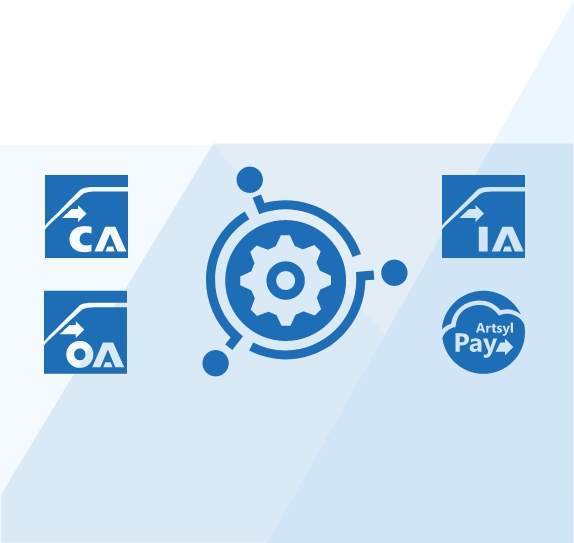In the fast-paced world of distribution, cash flow is king. However, managing a constant flow of incoming and outgoing payments can be a logistical nightmare for any distribution company.
Inefficient accounts payable (AP) and accounts receivable (AR) processes can lead to delayed payments, lost discounts, and strained relationships with suppliers and customers. To help you avoid that, in this article, we’ll explore the power of optimizing AP and AR for distribution companies.
We’ll discuss key strategies to streamline your processes, improve cash flow, and unlock greater efficiency within your financial operations as a distribution company. Read on to learn:

Streamline your distribution operations with Artsyl’s InvoiceAction.
Automate invoice processing from receipt to payment, eliminating manual data entry and reducing errors. Boost efficiency and accuracy in your AP management!
Main Accounts Payable (AP) Challenges for Distribution Companies
Distribution companies often rely on manual data entry and paper-based account payable processes, leading to errors, delays, and inefficiencies. These manual processes are time-consuming and prone to mistakes, increasing the risk of inaccurate payments and financial discrepancies.
Invoice Matching and Approval Delays
Matching invoices with purchase orders and receiving documents can be a cumbersome task. Delays in obtaining approvals from various departments can further slow down the payment process, leading to late payments and strained supplier relationships.
Also, controlling costs associated with the AP process, such as transaction fees, labor costs, and early payment discounts, is vital for profitability. Distribution companies need to find ways to optimize AP operations to minimize these costs while maintaining efficiency and accuracy.
Cash Flow Management
Maintaining a healthy cash flow is critical for distribution companies. Inefficient AP processes can lead to poor cash flow management, where the timing of outgoing payments does not align with incoming revenues, causing liquidity issues.
Fraud and Security Risks
The manual handling of invoices and payments increases the risk of fraud and unauthorized transactions. Ensuring secure AP processes and implementing robust fraud detection measures is a significant challenge for distribution companies.
Supplier Relationship Management
Timely and accurate payments are essential for maintaining good relationships with suppliers. Delays and errors in the AP process can damage these relationships, potentially leading to disruptions in the supply chain and affecting the overall business performance.
Compliance and Regulatory Requirements
Distribution companies must adhere to various compliance and regulatory requirements related to financial transactions and reporting. Maintaining these regulations and ensuring all AP processes comply can be challenging and resource-intensive.
High Transaction Volume
Distribution companies often deal with a high volume of transactions, making it difficult to manage and track payments efficiently. Handling large volumes of invoices and payments manually can overwhelm the AP department, leading to processing delays and errors.
Integration with Other Systems
Seamless integration of AP processes with other business systems, such as inventory management and ERP, is crucial for efficiency. Lack of integration can result in data silos, inconsistent information, and increased administrative workload.
READ MORE: Accounts Payable vs. Accounts Receivable
Handling Discrepancies and Disputes
Discrepancies between invoices, purchase orders, and delivery receipts can lead to payment disputes with suppliers. Resolving these disputes in a timely and satisfactory manner is a common challenge for AP departments in distribution companies.
Optimize your distribution workflow with Artsyl’s OrderAction. Simplify order consolidation, enhance operational efficiency, and improve supplier relationships. Reduce costs with automated order processing. See OrderAction in action!
Book a demo now
The Accounts Receivable (AR) Struggle is Real: Challenges for Distribution Companies
Distribution companies face a unique set of challenges when it comes to managing accounts receivable (AR). Unlike other industries, they often deal with high volumes of transactions, diverse customer bases, and tight profit margins. Here are some of the main AR hurdles distribution companies need to overcome.
Slow Payment Cycles
Distributors may grapple with extended payment terms offered to customers, leading to slow cash flow and potential delays in reinvesting back into the business.
Manual Processes
Reliance on manual invoicing and collections can be time-consuming, prone to errors, and inefficient in managing a high volume of transactions.
Customer Disputes
Discrepancies in orders, deliveries, or invoices can lead to customer disputes, further delaying payments and requiring additional resources to resolve.
Limited Visibility
Without clear and real-time data on outstanding invoices, it’s difficult for distributors to identify overdue payments and prioritize collections efforts.
Credit Management Issues
Inadequate credit control processes can lead to bad debt and write-offs, impacting profitability.
Discounts and Returns
Managing various discount structures and handling product returns can add complexity to the AR process and potentially tie up funds.
These challenges can significantly impact a distribution company’s financial health. But fear not! There are solutions available to streamline AR operations and improve cash flow. In the next section, we’ll explore some best practices for optimizing AR management in the distribution industry.
Taming the AR Beast: Best Practices for Distribution Companies
The challenges of accounts receivable (AR) management in the distribution industry are real, but there are effective strategies to conquer them. Here are some best practices to optimize your AR operations and ensure a healthy cash flow.
Embrace AR Automation
- Ditch manual processes and implement electronic invoicing (EDI) for faster and more accurate invoice delivery.
- Offer customers convenient online payment portals to streamline collections and shorten payment cycles.
- Set up automated email or SMS reminders for overdue invoices, nudging customers to settle payments promptly.
READ NEXT: Understanding the Accounts Receivable Process Cycle
Strengthen Credit Management
- Establish clear customer creditworthiness criteria and payment terms.
- Utilize credit scoring tools to assess customer risk and set appropriate credit limits.
- Develop a tiered collections strategy, starting with friendly reminders and escalating to stricter measures for persistent delinquencies.
Enhance Visibility and Reporting
- Invest in dashboards that provide real-time insights into outstanding invoices, overdue payments, and customer payment history.
- Generate reports to identify trends, analyze customer payment behavior, and track collections effectiveness.
Prioritize Customer Communication
- Ensure invoices are clear, accurate, and contain detailed information to avoid disputes.
- Address customer inquiries and resolve disputes promptly to maintain positive relationships.
- Consider offering flexible payment plans or discounts for early payments to incentivize timely settlements.
Leverage Technology Solutions
Cloud-based AR software solutions offer scalability, security, and accessibility for managing AR operations from anywhere. Ensure your AR software integrates seamlessly with your accounting system for streamlined data flow and efficient recordkeeping.
By implementing these best practices, distribution companies can significantly improve their AR management. Automated AR workflows, strong credit control, improved visibility, and clear communication with customers all contribute to faster collections, reduced risks, and a healthier bottom line. So, take control of your AR, and watch your cash flow flourish!
Enhance your distribution operations with Artsyl’s docAlpha. Automate document processing, streamline workflows, and improve accuracy and efficiency across your business. Discover the power of docAlpha today!
Book a demo now
Optimizing Accounts Payable (AP) Management in the Distribution Industry with Technology
Automation of Invoice Processing
Implement automated invoice processing systems to streamline the capture, validation, and approval of invoices. This reduces manual AP data entry, minimizes errors, accelerates processing times, and ensures timely payments. In addition, invoice automation leads to enhanced efficiency and fewer discrepancies.
Electronic Data Interchange (EDI)
Utilize EDI to facilitate seamless electronic transactions between distribution companies and their suppliers. EDI ensures accurate and timely exchange of purchase orders, invoices, and payment information, reducing paperwork and improving communication.
Cloud-Based AP Solutions
Adopt cloud-based AP management software to centralize and automate AP processes. The cloud provides real-time access to AP data, enhances collaboration among stakeholders, improves scalability, and ensures data security.
Integration with ERP Systems
Integrate AP management systems with enterprise resource planning (ERP) systems. Integration enables seamless data flow across departments, reduces data silos, improves financial visibility, and supports better decision-making.
Workflow Automation
Implement AP workflow automation tools to standardize and expedite the approval process for invoices. This speeds up the approval cycle, reduces bottlenecks, ensures compliance with internal policies, and enhances audit trails.
Optical Character Recognition (OCR) Technology
Use OCR technology to convert paper invoices into digital formats and extract relevant data OCR eliminates the need for manual data entry, improves accuracy, and speeds up invoice processing.
Supplier (Vendor) Portals
Establish supplier portals to facilitate self-service access for suppliers. Vendor portals allow suppliers to submit invoices, track payment status, and resolve discrepancies independently, reducing the administrative workload for the AP department.
Advanced Analytics and Reporting
Leverage advanced analytics and reporting tools to monitor AP performance and identify improvement areas. Analytics provides insights into payment trends, cash flow, and supplier performance, enabling more strategic AP management.
Robotic Process Automation (RPA)
Deploy RPA to handle repetitive and rule-based AP tasks such as data entry, invoice matching, and payment processing. RPA increases efficiency, reduces human error, and frees up staff for more value-added activities.
DISCOVER MORE: Machine Learning Accounts Receivable (AR) Solutions
Key Benefits of Optimizing AP Management with Technology
- Reduced labor costs associated with manual processing.
- Minimized late payment penalties and takes advantage of early payment discounts.
- Reduced errors through automation and digital data capture.
- Consistency and compliance with company policies.
- Accelerated invoice processing and approval times.
- Streamlined workflows and reduces administrative workload.
- Real-time visibility into AP liabilities and cash flow status.
- More strategic cash flow planning and management.
- Timely and accurate payments, enhancing trust and collaboration with suppliers.
- Transparency and self-service options through supplier portals.
- Business growth with scalable cloud-based solutions.
By embracing these technological solutions, distribution companies can significantly enhance their AP management processes, driving operational efficiency, cost savings, and improved supplier relationships.
From invoice processing to payment execution, Artsyl’s InvoiceAction covers all your invoicing needs. Experience seamless integration, improved accuracy, and faster invoice processing times. Find out how InvoiceAction can revolutionize your AP department!
Book a demo now
Understanding AP and AR in the Distribution Industry
What Is Invoice Processing?
Invoice processing is the procedure of handling incoming invoices from receipt to payment. This process includes verifying the invoice details, matching it with purchase orders and delivery receipts, and obtaining necessary approvals.
Automation tools can significantly speed up this process, reducing errors and manual workload. Efficient invoice processing ensures timely payments and accurate financial records. It is a critical component of both AP and AR management.
What Is a Purchase Order (PO)?
A purchase order (PO) is a formal document issued by a buyer to a supplier, detailing the types, quantities, and agreed prices for products or services. It serves as a legal contract between the buyer and the supplier once accepted by the latter.
POs help in tracking purchases, managing inventory, and controlling expenses. They are essential for matching invoices during the AP process to verify that goods or services were received as ordered. Using POs ensures transparency and accountability in procurement.
How Important Are Payment Terms?
Payment terms are the conditions under which a buyer agrees to pay a seller, typically detailed in the purchase order or sales agreement. Common terms include the payment due date, discount opportunities for early payment, and penalties for late payment.
Understanding and negotiating favorable payment terms can improve cash flow management for both AP and AR. For example, terms like «Net 30» mean payment is due within 30 days. Adhering to payment terms is crucial for maintaining good business relationships and financial health.
How to Calculate Early Payment Discount
An early payment discount is an incentive offered by suppliers to encourage buyers to pay invoices before the due date. It typically involves a percentage reduction in the invoice amount if payment is made within a specified period, such as «2/10 Net 30,» meaning a 2% discount if paid within 10 days.
Utilizing early payment discounts can lead to significant cost savings and improved cash flow. It also helps strengthen supplier relationships by demonstrating financial reliability. However, it requires careful cash flow management to ensure funds are available for early payments.
What Is an Aging Report?
An aging report is a financial document that categorizes a company’s accounts receivable or accounts payable based on the length of time an invoice has been outstanding. For AR, it shows which invoices are current and which are overdue, typically grouped by 30-day intervals.
For AP, it helps identify overdue liabilities and manage payment schedules.
Aging reports are crucial for monitoring cash flow, identifying potential collection issues, and making informed credit decisions. Regular review of aging reports helps in maintaining financial health and operational efficiency.
KEEP READING: Audit Trail in Accounts Payable and Accounts Receivable
What Is the Role of Cash Flow Management?
Cash flow management involves monitoring, analyzing, and optimizing the net amount of cash receipts minus cash expenses. Effective cash flow management ensures that a company has sufficient liquidity to meet its obligations and invest in growth opportunities. It involves managing both AP and AR to balance outflows and inflows efficiently.
Poor cash flow management can lead to liquidity crises, even if a company is profitable on paper. Tools like cash flow forecasts and aging reports are essential for effective cash flow management.
What Is Supplier Relationship Management?
Supplier relationship management (SRM) is the systematic approach to evaluating suppliers’ contributions and maintaining positive interactions with them. SRM involves collaboration, performance assessment, and continuous improvement in supplier relationships.
Effective SRM can lead to better payment terms, higher-quality products, and reliable supply chains. It is particularly important in AP management to ensure timely payments and resolve disputes.
Strong supplier relationships can result in cost savings, improved service levels, and innovation opportunities.
What Is the Role of Credit Control?
Credit control refers to the strategies and processes a company uses to manage the credit extended to customers and ensure timely payment. This includes setting credit limits, conducting credit checks, and regularly reviewing customers’ payment histories.
Effective credit control minimizes the risk of bad debts and improves cash flow. It is a critical component of AR management, helping to maintain a healthy balance between sales growth and financial stability. Regular monitoring and follow-up on overdue accounts are essential practices in credit control.
Accelerate your order-to-cash cycle with OrderAction. Automate order processing and payment collection to reduce delays and boost your cash flow. See how OrderAction can benefit your distribution business!
Book a demo now
Final Thoughts
Optimizing your AP and AR processes is an investment that pays off in a big way. Streamlined workflows, improved cash flow, and stronger supplier and customer relationships all contribute to a more resilient and successful distribution business.
By implementing the strategies outlined in this blog, you can transform your financial operations and free up valuable resources to focus on core business activities.
Remember, a few simple tweaks can lead to a significant impact on your bottom line. So, take control of your AP and AR, and watch your distribution company thrive!






 Resolving AP Challenges in Distribution with Process Automation
Resolving AP Challenges in Distribution with Process Automation Role of Certified Management Accountant in Accounts Payable
Role of Certified Management Accountant in Accounts Payable Expense Report: Its Role in Accounts Payable (AP)
Expense Report: Its Role in Accounts Payable (AP) Accounts Payable vs. Accounts Receivable
Accounts Payable vs. Accounts Receivable Accounts Payable Turnover Ratio: Formula, Understanding, Uses
Accounts Payable Turnover Ratio: Formula, Understanding, Uses AP Reconciliation: How to Reconcile Accounts Payable
AP Reconciliation: How to Reconcile Accounts Payable